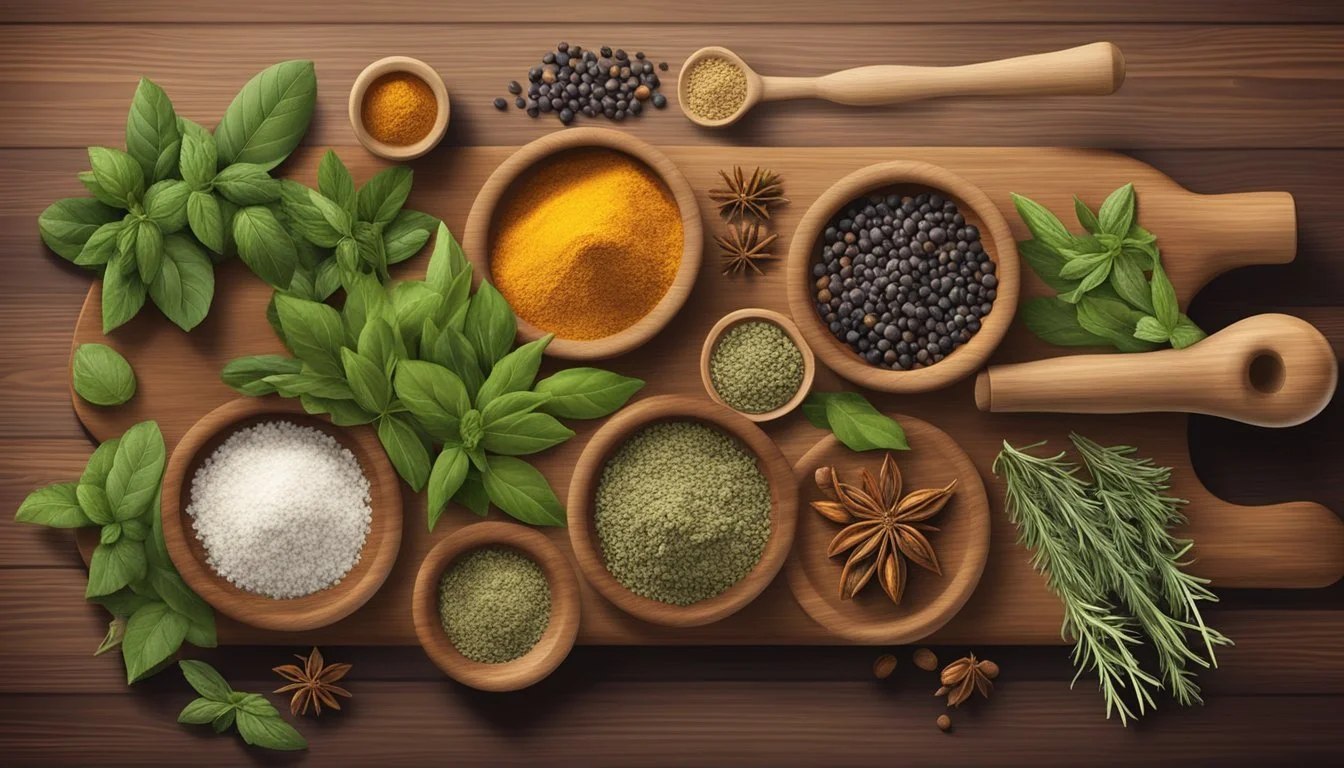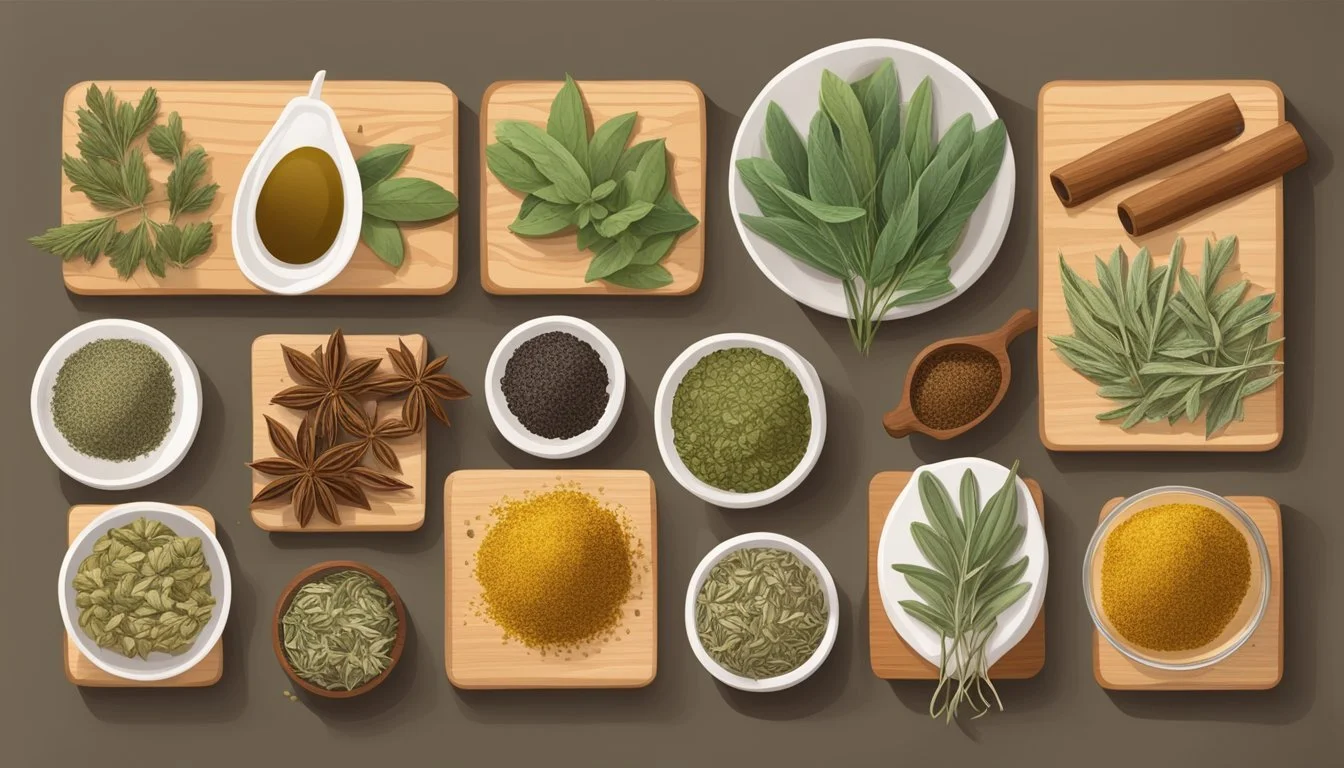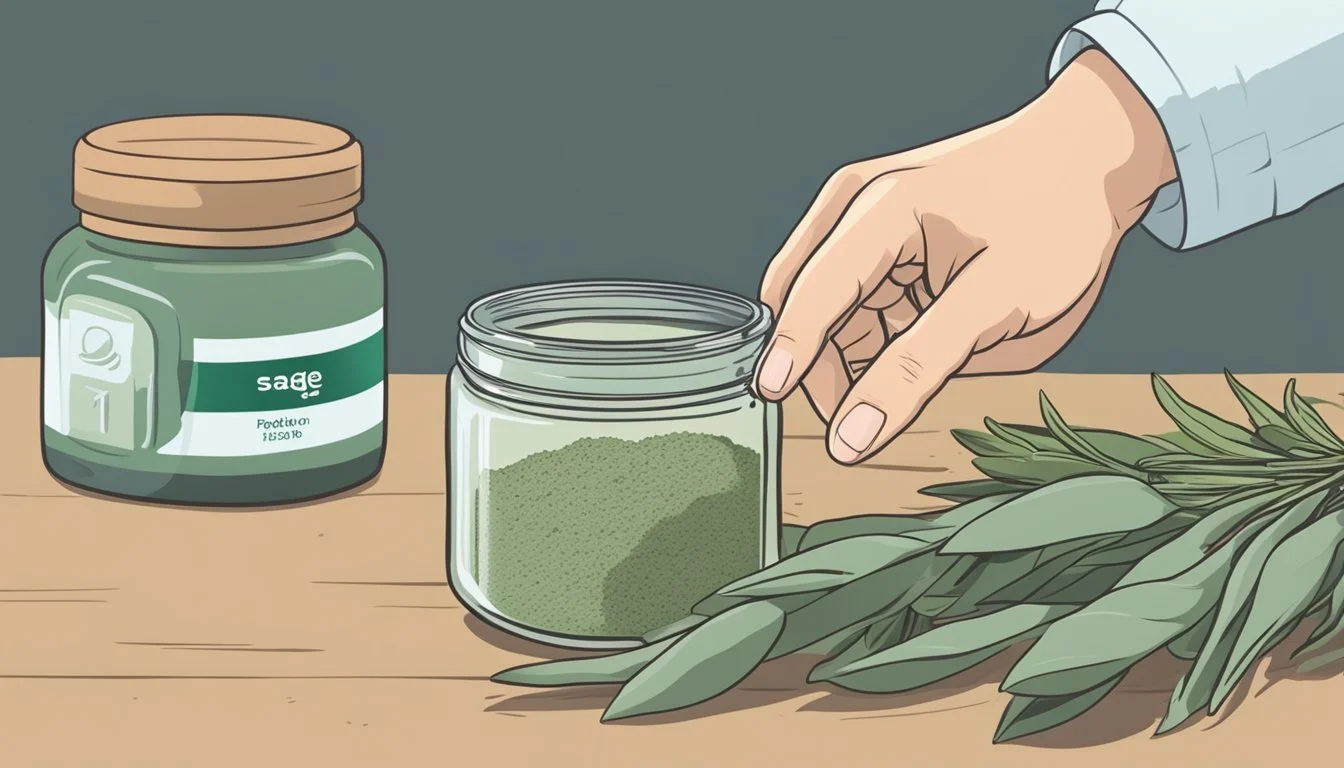Sage Substitutes
Top Alternatives for Your Recipes
Sage is an herb with a robust flavor profile, often described as slightly peppery with hints of mint, eucalyptus, and lemon. It is commonly used in a variety of culinary dishes, particularly in the preparation of meats and stuffing, and is a staple in holiday cooking. However, there are instances when sage is not readily available, or someone may simply prefer to explore other flavors. In such cases, knowing suitable substitutes for this herb can be incredibly valuable for both home cooks and professional chefs alike.
When replacing sage in a recipe, it is essential to consider the type and intensity of the substitute herb to achieve a balance of flavors. Herbs such as marjoram, thyme, and rosemary are often recommended replacements due to their similar flavor characteristics. Marjoram matches sage's warm and woody notes with a slightly more citrusy and floral undertone, while thyme offers a subtle, dry aroma with a mint-like quality. Rosemary, although more dominant with its woodsy, pine-like flavor, can be used sparingly to mimic sage’s earthiness.
It is important to use these alternatives in the right ratios to avoid overpowering the dish. Typically, one tablespoon of fresh sage can be substituted with one tablespoon of fresh marjoram or thyme. If using rosemary, a smaller quantity is advised because of its more assertive flavor. For dried herbs, the ratio is generally 1 teaspoon of dried substitute for every teaspoon of dried sage. These substitutes enable the cook to achieve a harmonious blend of flavors and ensure the success of the dish even in the absence of sage.
Understanding Sage
Sage is a distinct herb cherished for its pungent flavor and numerous applications that span from culinary delight to health and nutrition. This section aims to dissect the essence of sage, detailing its origins, culinary applications, and touted health benefits.
Origins and Characteristics
Sage, or Salvia officinalis, is an evergreen herb with a long history of use. It originated in the Mediterranean but has since spread across continents for its utility in gardens and kitchens alike. Noted for its grayish-green leaves and pleasant floral scent, sage possesses a robust, earthy flavor with a hint of pine-like flavor and subtle floral notes.
Culinary Uses of Sage
In terms of its culinary value, sage is highly versatile. It pairs exceptionally well with rich meats like pork, turkey, and poultry, and is an essential component in traditional stuffing recipes. Fresh sage leaves can impart a bright, aromatic taste, while dried sage offers a more concentrated flavor, suitable for a variety of dishes. In Mediterranean cuisine, sage enhances pastas, breads, and is a favored herb for seasoning.
Health Benefits of Sage
Beyond its use in the kitchen, sage is recognized for its health benefits. Rich in vitamins and calcium, sage can contribute to a nutritious diet. Herbalists value sage for its potential to support digestive health, cognitive function, and anti-inflammatory properties. The incorporation of sage into meals can bring not only depth of flavor but also an added nutritional boost.
Common Sage Substitutes
When searching for a sage substitute, consider the unique flavor profiles and cooking properties of these common herbs. Each substitute offers its own distinct taste and is best suited for particular dishes.
Rosemary as a Substitute
Rosemary's woodsy and pine-like flavor makes it a strong contender as a sage substitute, albeit in smaller quantities due to its potent taste. This Mediterranean herb shines in roasted meat dishes.
Using Thyme as an Alternative
Thyme carries a subtle, dry aroma with a hint of mint, making it a versatile sage substitute that pairs well with other spices. It works seamlessly in poultry seasoning and is a staple in many bean dishes for its savory depth.
Marjoram's Sweetness
Marjoram is similar to sage but with a sweeter and more delicate flavor profile. It's a perfect substitute in recipes where a lighter, less overpowering herbal note is desired, such as sauces and dressings.
The Versatility of Savory
Summer savory is known for its peppery and slightly bitter flavor, which can be a suitable substitute for sage, particularly in bean dishes. Savory blends well with other Mediterranean herbs.
When to Opt for Basil
With its fragrant and sweet aroma, basil is a cornerstone of Italian cuisine and stands as a good sage substitute, especially in pesto and other dishes where a hint of sweetness is preferred.
Oregano's Robust Flavor
Oregano offers a robust and somewhat bitter taste that makes it an excellent sage substitute in Italian seasoning. Frequently used in pizzas and stews, oregano adds a depth of flavor well-suited to hearty dishes.
Parsley's Mild Taste
Parsley has a milder taste that won't overpower other flavors in a dish, making it a suitable sage substitute in salads and lighter fare where its freshness can be appreciated.
The Unique Taste of Mint
Although a member of the mint family, mint often has a more pronounced lemony flavor. It serves as a surprising yet refreshing sage substitute in some Mediterranean recipes and beverages.
Substitute Blends and Dried Herbs
When fresh or dried sage is unavailable, various herb blends and dried herbs can serve as suitable substitutes, maintaining the flavor profile of the original recipe.
Homemade Poultry Seasoning
Homemade poultry seasoning is a sage substitute that typically includes dried thyme, rosemary, marjoram, and sometimes onion powder or garlic powder. A home cook can mix these dried herbs in equal parts to replace ground sage, giving a similar savory depth to dishes.
Italian Seasoning for Complexity
Italian seasoning, often found in pasta sauces, is another blend suitable for replacing sage, particularly in Mediterranean dishes. It contains a mixture of herbs like dried basil, oregano, rosemary, thyme, and sometimes dried parsley. One can use an equal amount of Italian seasoning when substituting for dried sage to create a complex and harmonized flavor.
Herbs de Provence and Sage
Herbs de Provence, a staple in French cuisine, includes a variety of dried herbs such as thyme, marjoram, and tarragon, with the occasional addition of lavender. While it doesn't include sage, its robust flavor can stand in for sage, especially in dishes that benefit from a floral note alongside the herbal bouquet.
Creating a Sage-Free Rub
For those needing a sage-free rub for meats, one can create a blend using dried rosemary, thyme, and black pepper. This rub can replicate the piney and slightly citrus flavor profile associated with sage. Each herb should be used in moderation and adjusted according to the intensity desired in the dish.
Specific Dish Alternatives
Selecting the right sage substitute can greatly influence the flavor and outcome of a dish. The following suggestions cater to specific culinary applications, ensuring complementary flavor pairings.
Poultry and Meat Dishes
When seasoning poultry dishes, such as turkey or chicken, marjoram offers a taste similar to sage but with a slightly sweeter undertone. For fatty meats like pork, rosemary provides a robust, pine-like flavor that complements the meat's richness.
Turkey Stuffing: 1 tbsp chopped fresh marjoram or 1 tsp dried marjoram
Roast Chicken: 1 tbsp fresh rosemary or 1 tsp dried rosemary
Vegetable and Potato Dishes
Thyme's versatile profile makes it an excellent substitute in vegetable and potato dishes. It blends well with the earthiness of root vegetables and the neutrality of potatoes.
Roasted Vegetables: Sprinkle thyme leaves before roasting.
Mashed Potatoes: Stir in finely chopped thyme to taste.
Substitutes in Soups and Stews
For a sage substitute in soups and stews, bay leaves can be used to impart a subtle, earthy flavor. Herbs de Provence, while more complex, can also enhance these dishes with its combination of savory flavors including thyme and marjoram.
Pumpkin Soup: 1 bay leaf during simmering
Beef Stew: 1 tsp Herbs de Provence for each tbsp of sage
Enhancing Pasta and Sauces
Oregano fits seamlessly into Italian cuisine, particularly in tomato-based pasta sauces. Basil, with its hints of anise, is best reserved for fresh, lighter sauces.
Tomato Sauce: Replace sage with oregano in equal parts.
Pesto Sauce: Substitute basil for sage, to flavor.
Seasoning Sausages and Game
For sausages and game, fennel seeds are a strong choice due to their licorice-like taste that complements rich meats. When using fennel as a sage substitute, its strong profile should be used sparingly.
Sausages: Crush a small amount of fennel seeds into the mix.
Game Birds: Lightly season with ground fennel for a warm, earthy accent.
Replacement Techniques and Ratios
When selecting substitutes for sage in recipes, it is crucial to understand the appropriate conversion ratios and how to balance the unique flavor profiles of alternative herbs.
Fresh vs Dried Herb Conversions
Converting between fresh and dried herbs is essential when substituting for sage. A general rule of thumb is a 1 to 3 ratio, meaning one part dried herb is equivalent to three parts fresh. This is due to the concentration of flavors in dried herbs compared to their fresh counterparts. However, when replacing sage specifically:
Fresh sage: Substitute with equal amounts of fresh marjoram or thyme.
Dried sage: Use equal amounts of dried marjoram or thyme, or adjust to taste.
For other herbs such as rosemary, which has a stronger flavor, less is required:
Rosemary: Use half the amount of rosemary when substituting for sage to avoid overpowering the dish.
Balancing Flavors in Dishes
The flavor profile of sage is robust with earthy, slightly peppery, and sweet undertones. It's imperative for cooks to consider the flavor balance when using substitutes to not overwhelm the dish. Here are some techniques and ratios for balancing flavors with sage substitutes in various dishes:
Poultry seasoning as a substitute for dried sage should be used in a 1:1 ratio for applications such as stuffing and meats.
Oregano offers a slightly different flavor but can be used in equal amounts for Mediterranean dishes like salad vinaigrettes, chicken, and pizza.
Rosemary should be used sparingly due to its woodsy and potent flavor—typically half the volume when exchanging for sage.
When a recipe calls for sage, and a substitution is necessary, it is recommended to start with a conservative amount of the substitute spice and adjust according to one's flavor preference, bearing in mind the distinct flavor characteristics that each alternative offers.
Tips for Growing and Harvesting
Successful cultivation and preservation of garden sage require adherence to optimal growing conditions and proper harvesting techniques. Adhering to these guidelines ensures a bounty of fresh herbs that can later be dried and stored for long-term use.
Growing Your Own Herbs
Sunlight: Garden sage thrives in full sun.
Soil: Well-drained soil is crucial; sage prefers a pH between 6.0 and 7.0.
Spacing: Ensure plants have ample space for airflow, which is vital in preventing fungal diseases.
Watering: Water the plants regularly but allow the soil to dry out between watering to avoid waterlogging.
Fertilization: Minimal fertilization is recommended as sage doesn't require rich soil.
Situate sage near plants like rosemary, cabbage, and carrots, which are compatible companions.
Avoid planting near cucumbers which may impede sage's growth.
Drying and Storing Homegrown Herbs
Drying Techniques:
Air Drying: Hang bunches of sage upside down in a well-ventilated area away from direct sunlight.
Oven Drying: Dry sage leaves in the oven at the lowest possible setting, keeping the door ajar to release moisture.
Storage Solutions:
Glass Containers: Store dried sage in airtight glass containers to protect from light and preserve flavor.
Freezing: Finely chopped sage can be frozen with water in ice-cube trays or with oil for easy addition to recipes.
Preservation Pointers:
Freshness: Harvest sage leaves before the plant flowers for optimal flavor.
Handling: Use sharp, sterilized pruning tools to prevent damaging the plant and reducing the risk of disease.
Cultural Significance and History
Sage has long been esteemed for its diverse applications, from spiritual ceremonies to culinary traditions. As an herb prominent in various cultures, its historic roots and roles continue to influence practices today.
Sage in Ancient Cultures
Historically, sage (Salvia officinalis), which originates from the Mediterranean region, was held in high regard by the ancient Greeks and Romans for its healing properties. They used it in traditional medicine for its perceived ability to enhance memory and promote wisdom.
In other parts of the world, such as North America, white sage (Salvia apiana) has been a sacred plant among Native American nations. It is traditionally used for purifying spaces, in healing ceremonies, and for spiritual cleansing—a practice commonly known as smudging.
List of Ancient Uses of Sage:
Medicinal: Utilized as an herbal remedy for various ailments.
Preservation: Believed to have antibacterial properties to preserve meats.
Spiritual: Used in ceremonial practices to cleanse and bless spaces.
Role of Sage in Holiday Cooking
During holidays, particularly Thanksgiving, sage plays a fundamental role in the culinary landscape. It’s incorporated as a key seasoning in stuffing or dressing, and it's often used to season the turkey, which is the centerpiece of this celebratory meal in the United States.
Table Highlighting Holiday Cooking Utilization:
Holiday Sage Utilization Thanksgiving Integral in stuffing and turkey preparation Christmas Added to holiday meats and festive dishes Other Holidays Used to flavor a variety of traditional foods
In both ancient times and modern holiday cooking, sage bridges the gap between past and present, adding both flavor and a touch of historical reverence to meals shared across generations.







